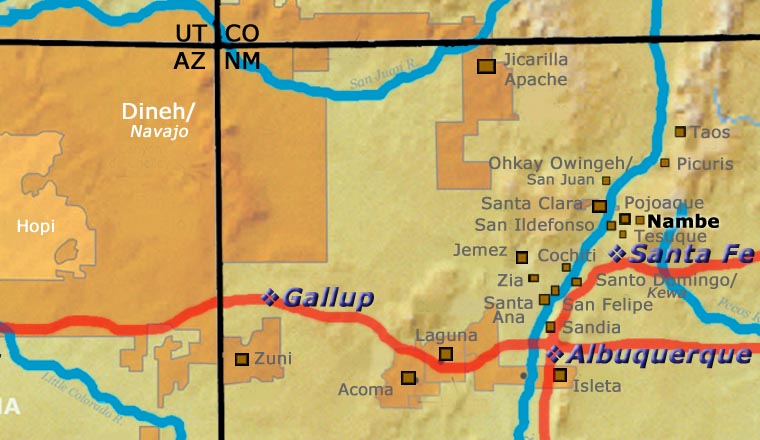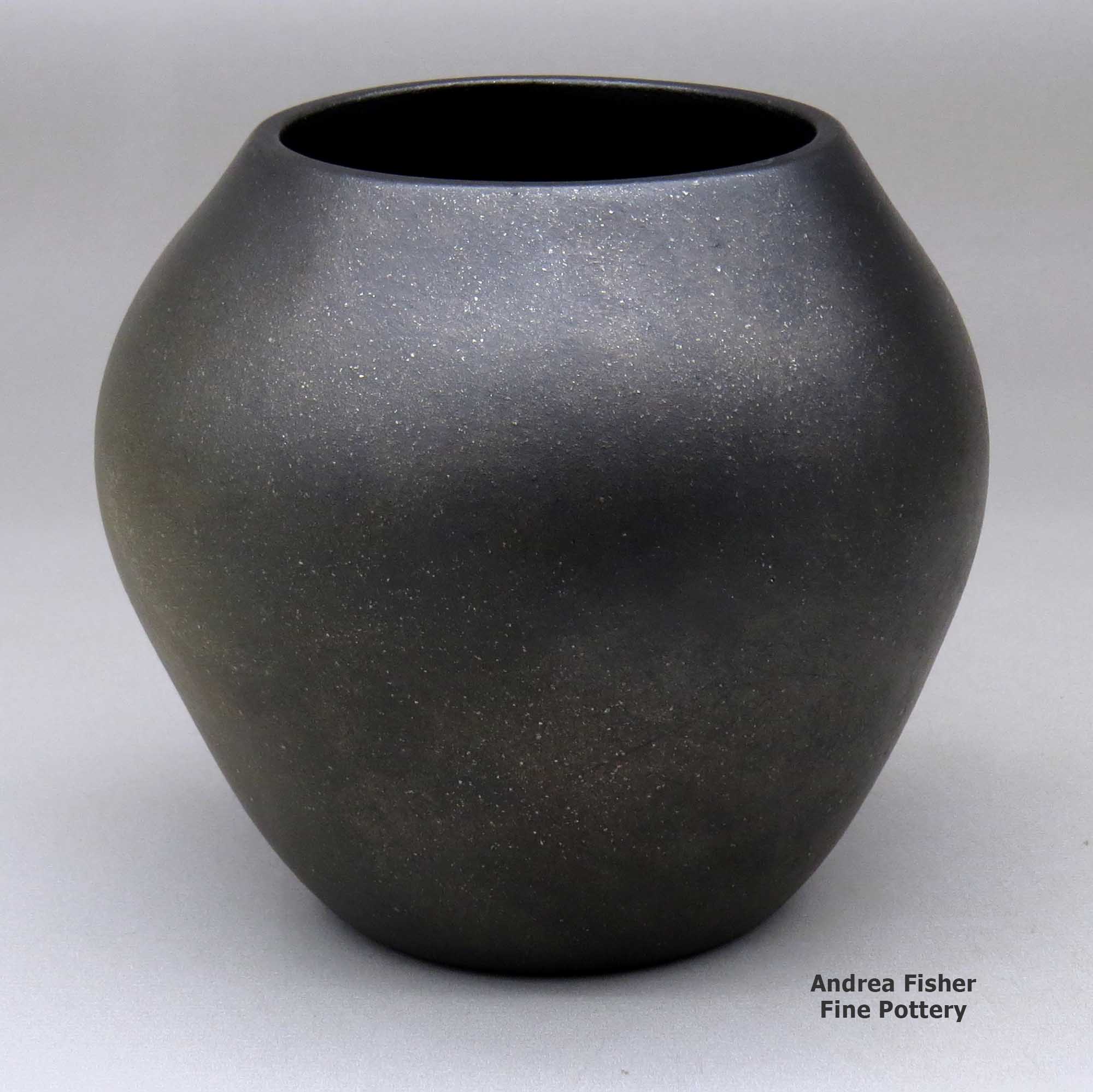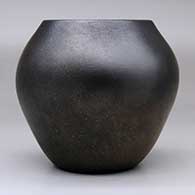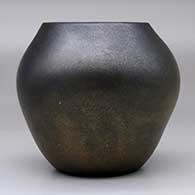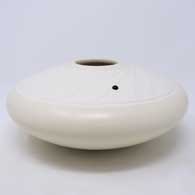
Robert Vigil
Nambe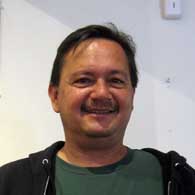
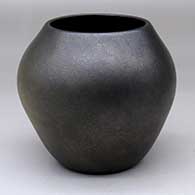
Half Nambe Pueblo and half Non-Pueblo, Robert Vigil was born to parents Joe and Alice Vigil in 1965. He first learned the method of making pots with clay coils while in high school in Texas. Then he returned to the pueblo and began to learn from folks like Virginia Gutierrez, his cousin Lonnie Vigil and then from Juan Tafoya of San Ildefonso Pueblo.
Robert has been active as a Nambe potter since 1990 working with micaceous jars, bowls, vases, figures and polished redware. Robert doesn't create giant storage jars like his cousin Lonnie as he much prefers to work on a smaller, more intimate scale, and coloring his micaceous pots with fire clouds and other variations produced by the reduction method of firing. There is an elegant purity to his simplistic and understated forms, a deep reflection of his soft spoken manner and gentle spirit.
Robert has told us he prefers the simple shapes and forms and even his carving is gentle. He gets his inspiration from the clay: "I just sit down and start and the clay forms itself through my hands." He's lately been teaching others at his pueblo how to make pottery the traditional way as he doesn't want to see that tradition get lost over time.
He has participated in shows at the Wheelwright Museum of the American Indian, at the Eight Northern Pueblos Arts and Crafts Show and at the First Micaceous Pottery Market in 1995 in Santa Fe.
Pieces of Robert's pottery are on display at the Minneapolis Art Institute in Minneapolis, MN, and at the Crocker Art Museum in Sacramento, CA.
100 West San Francisco Street, Santa Fe, New Mexico 87501
(505) 986-1234 - www.andreafisherpottery.com - All Rights Reserved

Nambé Pueblo

The main kiva at Nambé Pueblo
The area that is now Nambé Pueblo was likely settled in the 1300s CE after groups of Ancestral Tewa had made their way east from the Mesa Verde area to the San Luis Valley. From there they journeyed down the east side of the Rio Grande to the Nambé River basin. There, they traveled up streambeds and into the high country to settle, coming down to the lower Nambé River valley only in the summer to grow their crops. Eventually, they felt safe enough to stay in the lower valley year round and abandoned the higher mountain villages.
By 1600 CE, Nambé was a primary economic, cultural and religious center in the Tewa Basin (the valley of the Rio Grande between the Rio Grande Gorge and White Rock Gorge). Nambé's relative "wealth" attracted a large Spanish presence and the nature of that presence caused the Nambé people to join wholeheartedly in the Pueblo Revolt of 1680.
The Spanish returned in 1692. Their rule was a bit less harsh, however, the Spanish brought the first horses (and other domesticated livestock) into the New World and as the number of Spanish settlers increased, so did the number of wild horses. More horses brought more raids from the Utes, Navajos, Apaches and Comanches as they came looking for whatever they could carry away. The worst of the raiders, the Comanches, were finally subdued by Governor Juan Bautista de Anza in 1776 but by then, the impact of European diseases was overwhelming the people of Nambé. A smallpox epidemic in the late 1820s virtually ended the pueblo.
The Nambé pottery tradition is similar to that of Taos and Picuris in their use of micaceous clay slips but, like other villages in Tewa Basin, Nambé potters also used to produce white-on-red and all-black products, too. When Lonnie Vigil began producing his micaceous clay masterpieces in the 1990s, he almost single-handedly jump-started the revival of pottery making at Nambé.
100 West San Francisco Street, Santa Fe, New Mexico 87501
(505) 986-1234 - www.andreafisherpottery.com - All Rights Reserved

Nambe
$ 275
zzna4j050
An oval plain black micaceous jar with fire clouds
5 in L by 5.25 in W by 4.75 in H
Condition: Excellent
Signature: Robert Vigil Nambe
Date Created: 2024
100 West San Francisco Street, Santa Fe, New Mexico 87501
(505) 986-1234 - www.andreafisherpottery.com - All Rights Reserved

Micaceous Clay Pottery

Angie Yazzie
Taos

Christine McHorse
Navajo
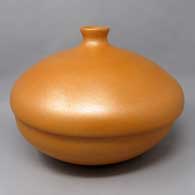
Clarence Cruz
San Juan/Ohkay Owingeh
Micaceous clay pots are the only truly functional Pueblo pottery still being made. Some special micaceous pots can be used directly on the stove or in the oven for cooking. Some are also excellent for food storage. Some people say the best beans and chili they ever tasted were cooked in a micaceous bean pot. Whether you use them for cooking or storage or as additions to your collection of fine art, micaceous clay pots are a beautiful result of centuries of Pueblo pottery making.
Between Taos and Picuris Pueblos is US Hill. Somewhere on US Hill is a mica mine that has been in use for centuries. Excavations of ancient ruins and historic homesteads across the Southwest have found utensils and cooking pots that were made of this clay hundreds of years ago.
Not long ago, though, the making of micaceous pottery was a dying art. There were a couple potters at Taos and at Picuris still making utilitarian pieces but that was it. Then Lonnie Vigil felt the call, returned to Nambe Pueblo from Washington DC and learned to make the pottery he became famous for. His success brought others into the micaceous art marketplace.
Micaceous pots have a beautiful shimmer that comes from the high mica content in the clay. Mica is a composite mineral of aluminum and/or magnesium and various silicates. The Pueblos were using large sheets of translucent mica to make windows prior to the Spaniards arriving. It was the Spanish who brought a technique for making glass. There are eight mica mining areas in northern New Mexico with 54 mines spread among them. Most micaceous clay used in the making of modern Pueblo pottery comes from several different mines near Taos Pueblo.
As we understand it, potters Robert Vigil and Clarence Cruz have said there are two basic kinds of micaceous clay that most potters use. The first kind is extremely micaceous with mica in thick sheets. While the clay and the mica it contains can be broken down to make pottery, that same clay has to be used to form the entire final product. It can be coiled and scraped but that final product will always be thicker, heavier and rougher on the surface. This is the preferred micaceous clay for making utilitarian pottery and utensils. It is essentially waterproof and conducts heat evenly.
The second kind is the preferred micaceous clay for most non-functional fine art pieces. It has less of a mica content with smaller embedded pieces of mica. It is more easily broken down by the potters and more easily made into a slip to cover a base made of other clay. Even as a slip, the mica serves to bond and strengthen everything it touches. The finished product can be thinner and have a smoother surface. As a slip, it can also be used to paint over other colors of clay for added effect. However, these micaceous pots may be a bit more water resistant than other Pueblo pottery but they are not utilitarian and will not survive utilitarian use.
While all micaceous clay from the area of Taos turns golden when fired, it can also be turned black by firing in an oxygen reduction atmosphere. Black fire clouds are also a common element on golden micaceous pottery.
Mica is a relatively common component of clay, it's just not as visible in most. Potters at Hopi, Zuni and Acoma have produced mica-flecked pottery in other colors using finely powdered mica flakes. Some potters at San Ildefonso, Santa Clara, Jemez and San Juan use micaceous slips to add sparkle to their pieces.
Potters from the Jicarilla Apache Nation collect their micaceous clay closer to home in the Jemez Mountains. The makeup of that clay is different and it fires to a less golden/orange color than does Taos clay. Some clay from the Picuris area fires less golden/orange, too. Christine McHorse, a Navajo potter who married into Taos Pueblo, uses various micaceous clays on her pieces depending on what the clay asks of her in the flow of her creating.
There is nothing in the makeup of a micaceous pot that would hinder a good sgraffito artist or light carver from doing her or his thing. There are some who have learned to successfully paint on a micaceous surface. The undecorated sparkly surface in concert with the beauty of simple shapes is a real testament to the artistry of the micaceous potter.
100 West San Francisco Street, Santa Fe, New Mexico 87501
(505) 986-1234 - www.andreafisherpottery.com - All Rights Reserved
